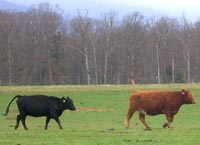UK Ag Economist Details State of Livestock Industry
UK Ag Economist Details State of Livestock Industry

Now is a key time for livestock producers to be analyzing markets and making decisions. Hog markets have tumbled since early August, so pig producers need to assess their options. Cattle markets have been unusually steady.
University of Kentucky College of Agriculture Economist Lee Meyer said live weight prices for hogs had declined 30 percent by early September.
"The reason for this drop has been clear," he said. "The amount of pork processed has been at near-record levels. Producers are feeling a double hit on profitability because the low prices are combined with much higher feed costs."
Meyer said it is unclear if the trend of record pork production will continue.
"Some fear the number of hogs marketed this fall will push capacity of slaughter plants to the limit," he said. "If so, the prices below 10 cents per pound in late 1998 and early 1999 could be repeated."
The optimistic view, which Meyer anticipates, is that today's high production levels mean slaughter later this year will be reduced. If that remains true, prices may already be as low as they will get.
One way hog producers can protect themselves against price risk is to use futures to set prices over the next year. Meyer said prices for this winter might be locked in in the mid $20s, with next summer's prices contracted in the $40s.
While hog producers are seeing price declines, feeder cattle producers are seeing significant price increases in the last month or two. When the drought was in full swing, many producers were thinking of selling instead of using the harvested hay for winter feeding.
That probably was not a good idea for most producers then and it is not a good idea for them now, Meyer said.
"In Kentucky, feeder prices typically decline about six percent from August to October and November," he said. "This year, the decline may be less than normal for two reasons. First, the drought in the Great Plains pushed a large number of calves to market early and second, slaughter prices are stable in the low $60s, but are expected to rise later this fall."
Meyer said the short-term decision for beef producers is to keep or sell.
"In the current market, it is profitable for most producers to keep calves that gain more than one pound per day, even if they need to be fed some hay," he said.
Another marketing option available to beef producers that may even be more profitable is the Certified Preconditioned for Health Program. Backgrounding is yet another viable option.
"My current analysis predicts returns of $30 to $50 per head for a five-month winter backgrounding program," Meyer said. "Producers without facilities or experience may want to sign on with one of the six custom weaning/backgrounding centers operated by the Kentucky Beef Network."
Meyer went on to say that producers with quality calves may want to budget the profitability of a retained ownership/finishing program. With the cost of corn near $2.50 to $3 per bushel, feedlot profits are thin. The breakeven price is about $70 per cwt for 600-pound calves placed at a cost of $80 per cwt.
More information about budgeting, custom backgrounding centers, retained ownership and the CPH program is available at county Extension offices.